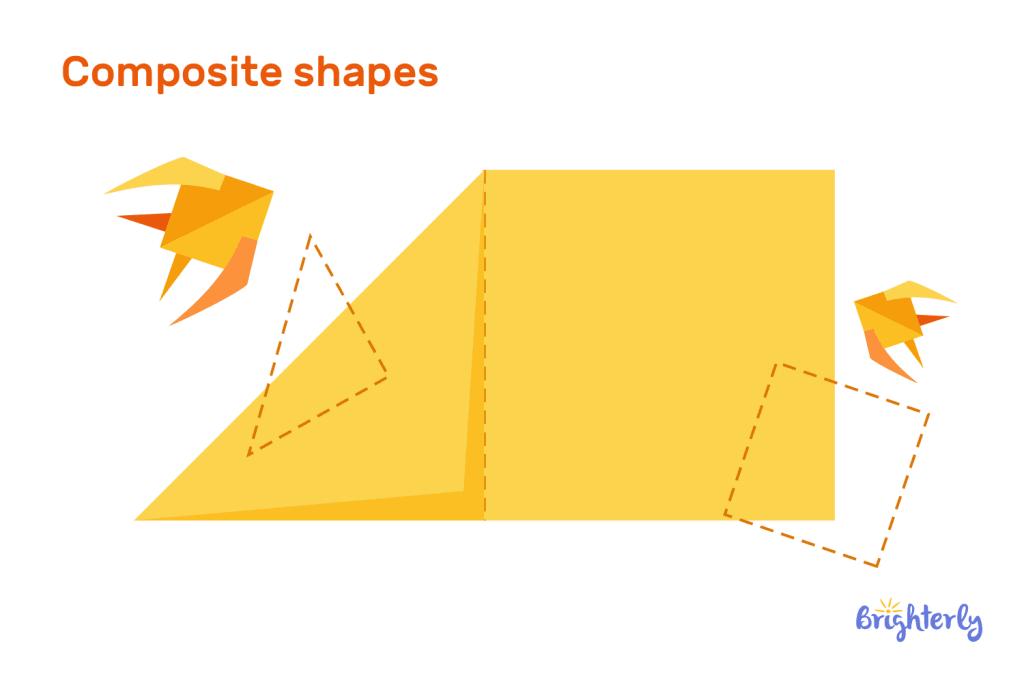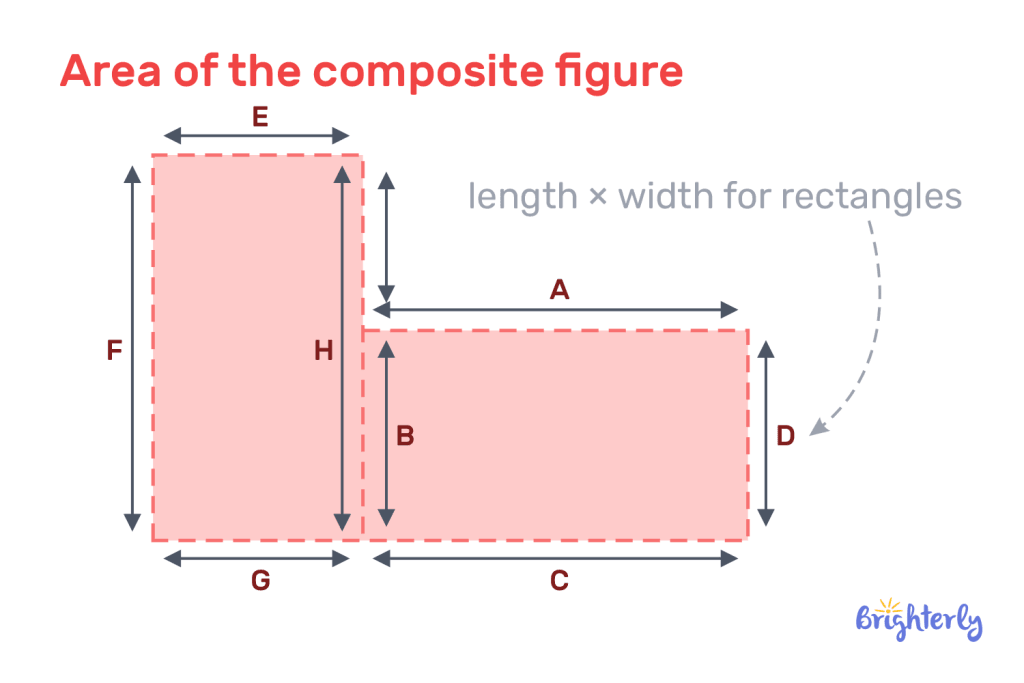Composite Shapes – Definition With Examples
Updated on November 28, 2025
Houses, treehouses, and sandwiches can all be broken down into squares, triangles, and circles. But when we go the other way and try to combine these simple shapes, we get the opposite, or a composite shape. In this article from Brighterly, you’ll learn what composite shapes are, how to use them, and how to work with them.
What are composite shapes?
Composite shapes are shapes created by combining several basic shapes. Pick one of your favorite shapes: triangles, squares, rectangles, or circles! Together, they create something truly unique.

We refer to them as composite because they are composed of various components, much like a smoothie blends fruits! If you’ve ever wondered what is composite shape is, it’s just a figure created by combining two or more basic shapes. Since composite shapes are present in everything from toys to buildings, geometry is both useful and entertaining.
Diving deeper into composite figures
Let’s look at some fun examples to make this super clear!
Composite figure example #1: A house made of shapes
A house can be depicted as a composite figure because it is constructed from simple shapes. You can draw the walls as a square and the roof as a triangle. The entire house is created when these two shapes are combined. This illustration demonstrates the process of joining two or more basic shapes to create what is a composite figure. Knowing this makes it easier to divide bigger, more complicated shapes into smaller, simpler components.
Composite figure example #2: Creating an ice cream cone
An ice cream cone is another example of a composite figure. The cone part can be represented as a triangle, and the scoop on top as a circle. By combining the triangle and the circle, you get the full ice cream shape. This demonstrates that composite figures are formed by joining simple shapes, which makes it easier to calculate areas, plan measurements, or solve geometry problems involving more complex figures.
Why are composite shapes important?
Everywhere you look, there is a composite shape. Whether it’s your backpack, phone, pizza slice, or car, everything is made up of basic shapes. Using this composite shape definition, you can see how simple shapes can be combined to form bigger, more complex ones.
You also gain a better understanding of space and dimension when you understand the composite figure definition. Architects, engineers, and game designers use them to create buildings, bridges, parks, and even video game worlds.
They also make problem-solving easier. Large, complex shapes can be broken into smaller, familiar shapes, making calculations like area or perimeter simpler. That’s why knowing them makes solving geometry problems much easier and more intuitive.
Bonus: Even grown-ups who build houses (architects), design toys, or plan parks use composite figures examples every day. And when you draw, color, or build with blocks? You’re already practicing them too! Understanding composite figures makes drawing, designing, and even organizing your room much simpler.
So yeah, composite shapes are a big deal. They make math fun, help you think smart, and are hiding everywhere you look, just waiting for you to spot them!
Some fun activities for composite shapes
The following are some easy ways to practice working with composite figures:
- Find objects made up of multiple shapes in the backyard, such as a slide (triangle + rectangle) or a birdhouse (square + triangle). You can draw the composite figure and label the smaller shapes that make it up.
- Combine fruit, cheese, and crackers to create a snack shape. Round crackers are the head, triangle cheese is the hat, and rectangle grapes are the body.
- Make 3D composite shapes with playdough, modeling clay, or building blocks. Using a cube and a cone, build a tower. A 3D composite shape can be used to illustrate the practical application of the technology.
- Cut out circles, squares, and triangles from colored paper to make robots, flowers, or rockets.
- Building a block tower is the goal of the block tower challenge, where each level symbolizes a composite figure (such as a triangle atop a rectangle). Can you tell me how many smaller shapes you used?
What is the area of the composite figure?
A composite figure’s area can be calculated by breaking it into simpler shapes, such as triangles, circles, or rectangles. Using the appropriate composite figure formula, such as length × width for rectangles or ½ × base × height for triangles, you determine the area of each smaller shape. Then, you add or subtract the areas depending on how the shapes are combined or overlapped. This technique makes it simpler to measure intricate shapes precisely.

Calculating the area of composite shapes
A simple way to measure the area of a big shape is to break it into smaller ones. For your reference, here are some composite shapes examples:
Composite figure example #1: A park with a circular pond
Imagine a rectangular park with a round pond in the middle. To get just the grass (not the water), follow these steps:
- Calculate the area of the entire rectangle.
- Calculate the area of the pond (the circle).
- Subtract the circle’s area from the rectangle’s area to find the grassy area.
Composite figure example #2: An “L” shaped room
Imagine an L-shaped room as one of those composite 3D shapes made up of two simple shapes. Separate each section into a rectangle. The area of each segment should be calculated independently by measuring its dimensions. When both results are combined, the total space can be calculated.
Conclusion
When figures are broken down into smaller, easier-to-understand parts, they can be managed quickly. That’s how you can work with their areas, perimeters, and geometry problems. Having these skills is useful for everyday tasks such as organizing spaces and working with 3D models, as well as math exercises.
Understanding composite shapes names and concepts improves logical reasoning, problem-solving skills, and spatial awareness. When you combine smaller shapes into larger ones, you can solve problems step by step, whether you’re working with 2D figures on paper or making 3D composite shapes. Practice makes it easier to measure, calculate, and understand how shapes fit together.
Frequently asked questions on composite shapes
What is a composite shape?
A composite shape is one made up from combining two or more basic shapes, like circles, squares, or triangles.
What are the basic shapes that make up composite shapes?
The basic shapes to make up composite shapes are circles, rectangles, squares, triangles, and semicircles.
How can I identify composite shapes in real life?
To identify composite shapes in real life, you’ll have to seek out the objects that seem composed of two or more other shapes, like windows, doors, and playground equipment.
How does learning about composite shapes help in real life?
Learning about composite shapes helps in real life by giving you the clue on how to measure areas, plan spaces, and understand designs in art, games, homes, and everyday objects.
Can a composite shape include 3D shapes?
Yes, 3D composite shapes can be made by combining cubes, cylinders, cones, or spheres, like a toy robot or a building model.






